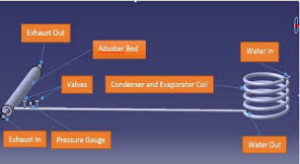
(I) INTRODUCTION
In modern scenario automobile air conditioning have two major problems.
(1.1) Limited fossil Fuel: Traditional and mobile air-conditioned driven by engine of automobile.
According to static information the efficiency of internal combustion engine is 30 % and 70 %
of energy is wasted to atmosphere. Depending on the engine load the exhaust load after the
catalytic convertor reach about 300-500 degree centigrade with turbo charger and 600-800
degree centigrade without turbo charger .The cost of fossil fuel increasing day by day and
availability of fuel is limited in future and pollution control of automobile is major issue. Pie
diagram shows the energy conversion of internal combustion engine.
(1.2) Automobile refrigerants produce serious environment problem: Existing traditional and
non natural working fluids like chlorofluorocarbons (CFC’s) are serious effect on both ozone
depletion potential global warming. Montreal protocol (1987) and Kyoto protocol (1997) come
in picture in new scenario. Main components of Automobile air conditioning are used now days
in hatchback, sedan or SUV car.
(1.3) Disadvantages of existing Automobile Air conditioning
reduce the efficiency of automobile air conditioner
(1) High cost of refrigerant.
(2) Total equipment quite heav
(3) System runs noisily.
(4) Over loading and overheating of the system take place
(5) Leakage problem of refrigerant which damage the ozone layer.
(1.4) Vapour Absorption Automobile Air conditioning System
Vapour Absorption refrigeration sy
but compressor is replace by a generator and absorber. The two
Absorption refrigeration systems are generally used.
1. Single stage Lithium Bromide – Water vapour Absorption Refrigeration system
2. Single stage Aqua-Ammonia Vapour Absorption refrigeration system
In LiBr-H2O absorption refrigeration system water as a refrigerant and lithium bromide as a
absorbent and Aqua Ammonia refrigeration system ammonia as a refrigerant and water as a
absorbent. Research work carried by different investigator on Exhaust waste heat of internal
combustion engine used as heat source of absorption refrigeration system. Ghassemi presented his
worked Ammonia water absorption refrigeration system for automobile application. This setup show
the condenser is situated top of the automobile and evaporator is inside of the fuel cost and capital
cost of the system decreases and overall COP are 0.29[1]. Keating invented absorption refrigeration
system for mobile application and had a patent in 1954. This system is applicable for vehicle, boats,
railways cars[2]. MeNamara designed a diesel, steam I.C. engine or turbine operated absorption
machine and had patent 1972. This system was using a mixture of water ammonia helium three fluid
systems[3] Akerman investigated a automobile air-conditioning system using exhaust of internal
combustion engine. His worked basically used two different absorption cycles with different
refrigerant pairs[4]. Vicent et. al presented a tuck refrigeration system using waste heat of exhaust
gases available at tail pipe of internal combustion engine additionally the main feature which given
by Vincent is used as a eutectic plate storage system for slow aped or parking condition of truck[5].
Horuz’s presented by experimental investigation of exhaust gas operated ammonia-water absorption
refrigeration system[6]. Salim M. simulated theoretically automobile Lithium Bromide water single
stage absorption refrigeration system taken heat from internal combustion engine exhaust gases. This
system is also useful for water cooled and air cooled condition and ABSIM software is used for
calculation purpose[7]. Shah Alam presented three fluid vapour absorption refrigeration system, run
by four cylinder, four stroke passenger car. The capacity of car air conditioner is one ton. He shows
that the heat required for air conditioner is more than double amount are available on engine
exhaust[15].Talom, Beyene study on a project in which a 10.55 kW (three ton) absorption chiller
was modified for hot gas intake and matched to a 2.8 L V6 internal combustion engine.
Mathematical model and experimental test results suggest that the concept is thermodynamically
feasible and could significantly enhance system performance depending on part-load of the
engine[9]. Ramanathan et al. simulated an automotive air-conditioning system based on absorption
refrigeration cycle. By developing a steady-state simulation model performance analysis of vapor
absorption refrigeration system is done. The water lithium bromide pair is used as a working mixture
for its favorable thermodynamic and transport properties compared to the conventional refrigerants
utilized in vapor compression refrigeration applications. The pump power required for the proposed
vapor absorption refrigeration system is found lesser than the power required operating the
compressor used in the conventional vapor compression refrigeration system. A possible
arrangement of the absorption system for automobile application is proposed[10]. In this paper
Boonnasaa et al. [11] studied the means to improve the capacity of the combined cycle (2 gas
turbines and 1 steam turbine unit) power plant. The most popular way is to lower intake air
temperature to around 15 deg. C and 100% RH before entering the air compressor of a gas turbine
(GT). This research proposes a steam absorption chiller (AC) to cool intake air to the desired
temperature level. Cooling inlet air would increase air mass flow, and then increase the power
output[11].In this paper Wang et al. reported the results of a study on the performance of an
automotive air conditioning system with measuring the vapor quality. The coefficient of
performance, evaporator cooling capacity, compressor power consumption, total mass flow rate,
vapor mass flow rate, liquid mass flow rate and oil in circulation, pressures and temperatures of
refrigerant at every component are measured and analyzed [12].Pise et al. carried out extensive
investigation on the enhancement of heat and mass transfer in absorbers of LiBr-H2O refrigerating
system. It is showed that the heat and mass transfer in the absorber can be improved by creating
wavy and turbulent flows by means of introducing extended surfaces, splashing using additives or
simply by increasing the solution flow Reynolds No. Schmidt and [26]. Groll also carried outinvestigation of evaporation cooling surfaces for automobile air-conditioning system and found that
the evaporative cooling techniques resulted in an effective method of cooling effects produced for
automobile air-conditioning system[27].
Objective of this study to study the performance and feasibility of vapour absorption based
automobile air-conditioned using exhaust waste heat or low grade energy.
Leave a Reply Cancel reply
Categories
- Animal27
- Apps3
- Art70
- Auto50
- Business175
- Career1
- Education114
- Faith62
- Family186
- Fashion35
- Food67
- Gadgets16
- Gaming13
- Health139
- Hobby134
- Holidays26
- Home96
- Legal11
- Marketing40
- Money96
- News130
- News30
- Other Stories4
- Pet1
- Photography14
- Poem23
- Science28
- SkyPip3
- Social Network75
- Society159
- Software23
- Technology125
- Travel69







Leave a Reply